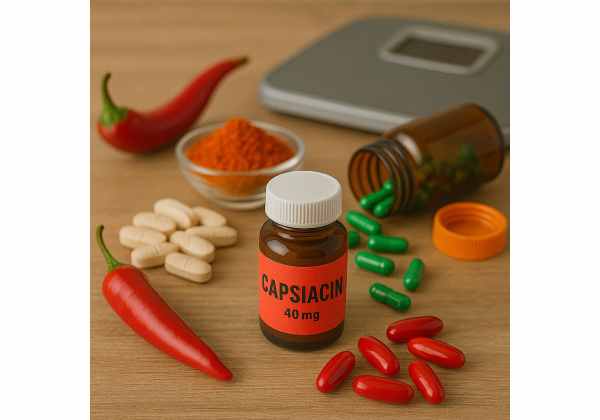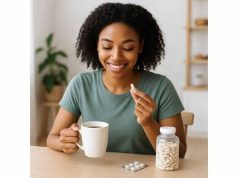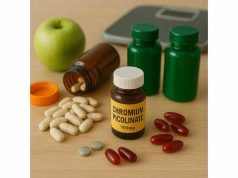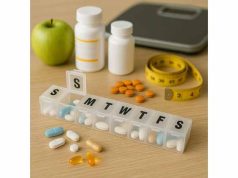
Chili heat has long been blamed—or credited—for a faster metabolism. Today, capsaicin (the spicy compound in hot peppers) and capsiate (a non-pungent cousin from sweet peppers) show up in “thermo” supplements and powdered add-ins that promise calorie burn. What can these compounds realistically do, and how do you use them without upsetting your stomach? This guide separates signal from noise. You will learn how capsaicin and capsiate affect thermogenesis, appetite, and tolerance; how to dose and time them; and who should avoid them. For a wider look at non-surgical tools alongside prescriptions, see our overview of evidence-based medical and supplement options.
Table of Contents
- Does capsaicin help with weight loss?
- How capsaicin and capsiate boost thermogenesis
- Dose, timing and forms that work
- Common mistakes and tolerance
- Safety, side effects and who should avoid
- What the research actually shows
- Who should try it and practical alternatives
- Frequently asked questions
Does capsaicin help with weight loss?
Capsaicin is the alkaloid that gives chili peppers their burn. Capsiate and related “capsinoids” come from a non-pungent cultivar; they engage many of the same receptors without the spicy sensation. Both compounds can slightly raise energy expenditure and, in some people, reduce appetite or snacking after meals. Think of them as small, supportive nudges that work best when layered onto a solid plan.
What “small” means in practice
- Thermogenesis: Expect a modest bump in calorie burn for a few hours after a dose—helpful, but not a substitute for nutrition and activity.
- Appetite: Some people feel fuller on smaller portions, especially when capsaicin is paired with protein and fiber-rich meals. Others notice no change if meals are already high in protein or if spicy foods trigger heartburn.
- Training support: Mild increases in fat oxidation at lower intensities can make steady-state cardio feel easier, but the effect is subtle compared with improvements from sleep, hydration, and pacing.
Who tends to benefit
- Individuals with variable appetite who do well with simple pre-meal routines.
- People who enjoy spicy food or who prefer a non-stimulant aid compared with caffeine.
- Those who are building consistent habits—protein at each meal, daily steps, and two to three strength sessions weekly.
Who sees little impact
- Highly active, lean individuals with stable glucose control.
- People with reflux or IBS, who often find capsaicin aggravating.
Capsaicin is a tool, not a shortcut. If you are still laying the foundation—protein, fiber, steps, strength, and sleep—start there. For a concise framework, see safe, sustainable basics in healthy weight loss guidance.
How capsaicin and capsiate boost thermogenesis
Capsaicin and capsiate activate TRPV1 receptors—heat-sensing channels found on sensory neurons and in the gut. This activation increases sympathetic nervous system activity and releases catecholamines, nudging thermogenesis (calorie expenditure from heat) and shifting fuel use slightly toward fat at low-to-moderate intensities.
Mechanisms in plain language
- Thermogenic spark: After a dose, your body produces a little extra heat. The increase is small and time-limited but can add up when paired with movement.
- Fuel shift during easy effort: At walking pace or easy cycling, your body may lean more on fat for fuel for an hour or two after dosing. At higher intensities, carbs still dominate.
- Possible appetite effects: By acting on gut–brain signaling, some people feel earlier fullness or less interest in snacks, particularly when a meal includes lean protein and vegetables.
Capsaicin vs. capsiate
- Capsaicin is pungent. It can irritate the mouth, esophagus, and stomach at higher intakes, especially in people prone to reflux.
- Capsiate (and dihydrocapsiate) are non-pungent; they engage similar receptors but cause far less GI burning. Many tolerate capsinoids better at “thermogenic” doses.
Synergy with routine
Capsaicin works best when it reinforces habits you can keep: a short pre-meal ritual, a brisk walk after lunch, or a steady-state cardio session. If you already use caffeine for training, you can compare roles and timing with our guide to caffeine timing. Avoid stacking multiple stimulants.
Genetic differences
People vary widely in TRPV1 sensitivity and spice tolerance. That is why one person feels warm and satisfied on less food while another notices only heartburn. Start low, evaluate, and keep only what proves helpful for you.
Dose, timing and forms that work
Use the lowest effective dose that delivers a noticeable benefit (warmth, satiety, steadier appetite) without GI discomfort or sleep disruption. A simple, repeatable routine beats chasing high doses.
Doses commonly used
- Capsaicin (capsaicinoids): many supplements provide 2–10 mg total capsaicinoids per day, split with meals. Food-only approaches vary widely because pepper heat units differ dramatically.
- Capsiate (capsinoids): often 3–12 mg/day, split with meals. Capsinoids are generally better tolerated at these intakes.
Timing
- Pre-meal: Take a dose 10–30 minutes before a main meal to test appetite effects. Pair with protein and fiber for best results.
- Pre-cardio: If you do easy steady-state work, dosing 30–60 minutes before may make the session feel smoother.
- Cut-off: Avoid late-evening doses if you are prone to reflux or if warmth interferes with sleep.
Food vs. supplement
- Food route: Add chili to soups, stir-fries, eggs, or bean dishes. Combining with yogurt, avocado, or broth can soften the burn. This route also supplies micronutrients and fiber.
- Supplement route: Choose products that disclose milligrams of capsaicinoids or capsinoids per serving. Avoid blends that hide totals.
How to run a fair trial
- Baseline: Track three things for a week—how hungry you feel two hours after meals, snack frequency, and any reflux.
- Intervention: Use a low dose with lunch or dinner for 14–21 days. Keep meals protein-forward and high in vegetables.
- Adjust: If you see no appetite benefit or you develop GI symptoms, lower the dose or stop. If the effect is clear and comfortable, continue for a full 8–12 weeks.
Label literacy and quality
Look for clear standardization (mg of active capsaicinoids/capsinoids). Prefer brands that document third-party testing to reduce contamination risk and dose variability. If label reading is new, our primer on interpreting supplement labels can help you spot red flags quickly.
Common mistakes and tolerance
1) Chasing big doses for big burn
More heat does not mean better results. High intakes increase reflux, nausea, and stomach pain. Small, steady doses with meals are more sustainable.
2) Taking it on an empty stomach
This invites discomfort without improving thermogenesis. Pair with food—ideally lean protein and vegetables.
3) Ignoring tolerance
With daily exposure, TRPV1 receptors can desensitize. Appetite effects can fade over weeks. If this happens, take a 7–10 day break or rotate food-based spice with capsinoids to reset sensitivity.
4) Using it as a hall pass
Capsaicin will not cancel liquid calories or late-night snacks. Keep your core habits—protein first, fiber, steps, strength, and sleep—front and center.
5) Stacking stim-heavy “fat burners”
Many formulas combine capsaicin with high caffeine and other stimulants. This raises heart rate, jitters, and GI risk without better outcomes. If stimulant blends tempt you, read the safety notes in fat burner risks before you buy.
6) Overlooking hydration
Mild diuresis from caffeine (if you also use it) and heat sensations can make you under-drink. Keep water or unsweetened electrolytes nearby, especially around exercise.
7) Spicy late dinners
Even if you tolerate capsaicin at lunch, a spicy late meal can provoke night-time reflux. Shift your dose earlier, or use capsinoids if evenings require flexibility.
Safety, side effects and who should avoid
Most healthy adults tolerate modest, meal-timed intakes of capsaicin or capsinoids. Still, respect the boundaries—especially if you have GI or cardiovascular concerns.
Common side effects
- GI irritation: burning in the mouth or chest, reflux, stomach discomfort, nausea, or diarrhea—typically dose-related.
- Warmth or flushing: a temporary, harmless heat sensation.
- Cough or throat irritation: more common with powders or if capsules open early.
Who should avoid or seek medical guidance
- GERD, gastritis, peptic ulcers, or IBS: capsaicin often worsens symptoms; capsinoids may be gentler but still use caution.
- Pregnancy and breastfeeding: insufficient safety data—avoid unless your clinician specifically approves.
- Uncontrolled hypertension or arrhythmia: avoid high-stimulant stacks; discuss single-ingredient use with your clinician.
- Upcoming surgery: spicy GI irritation and variable supplement quality are not worth the risk—pause unless your surgical team advises otherwise.
- Allergy to peppers (rare): avoid.
Medication considerations
- Be cautious combining with multiple stimulants or high-dose caffeine.
- If you use antacids or acid-suppressing medications, capsaicin may still trigger symptoms; timing does not fully prevent reflux.
- For people on weight-loss prescriptions (e.g., GLP-1 medicines), capsaicin is usually unnecessary; the medication already targets appetite effectively. If you are considering prescriptions, review candidacy and trade-offs in prescription options explained.
Practical safety rules
- Start low. If you feel burning, halve the dose or switch to capsinoids.
- Keep doses with meals and avoid late-night spicy meals.
- If symptoms persist—stop. There is no benefit in pushing through GI pain.
What the research actually shows
General pattern
Studies on capsaicin and capsinoids are typically small and short (weeks to a few months). They show modest increases in energy expenditure and small reductions in energy intake for some participants. Individual response varies widely.
Thermogenesis
After dosing, resting energy expenditure rises for several hours—think tens of calories, not hundreds. Repeated daily dosing may sustain a small advantage, particularly when paired with movement and adequate protein.
Appetite and intake
Some trials report lower calorie intake at the next meal or later in the day, especially when meals are protein-forward. The effect is less consistent in people already accustomed to spicy foods or with high habitual protein.
Capsaicin vs. capsinoids
Non-pungent capsinoids (e.g., capsiate and dihydrocapsiate) tend to produce similar thermal effects with better GI tolerance. This is why many commercial “capsinoid” products aim for 3–12 mg/day rather than chasing higher capsaicin doses.
Body weight and waist
Weight change over 8–12 weeks is generally small unless accompanied by a structured diet and activity plan. Some studies suggest slightly better waist reductions (visceral fat proxy) even when the scale changes modestly.
Tolerance and novelty
Appetite effects can fade with receptor desensitization. Cycling off for one to two weeks or switching between food-based spice and capsinoids can restore responsiveness.
Bottom line
Capsaicin and capsinoids can nudge thermogenesis and appetite in your favor. They will not replace calorie awareness, protein, fiber, steps, strength training, and sleep. If you do not notice a clear, comfortable benefit in 2–4 weeks, it is reasonable to stop and focus elsewhere. For comparison with other gentle aids, see catechin-caffeine pairing in green tea extract basics.
Who should try it and practical alternatives
Good candidates
- Adults who enjoy spicy flavors or prefer a non-stimulant option.
- People whose main struggle is between-meal snacking rather than meal size.
- Those who can keep doses with meals and away from bedtime.
A simple plan to test
- Choose one main meal (often lunch).
- Take a low dose of capsaicin (2–4 mg capsaicinoids) or capsiate (3–6 mg) 10–30 minutes before.
- Build the plate: protein first, then vegetables, then starch.
- Track hunger two hours later and snack frequency that evening for 14–21 days.
When to skip
- You have reflux, ulcers, IBS, or capsaicin consistently disrupts sleep.
- You expect prescription-level weight loss from supplements. Choose the right tool for the job.
Alternatives that often deliver more
- Protein plus soluble fiber at meals (beans, lentils, oats, chia, psyllium) to improve fullness; see practical options in fiber supplements for appetite.
- Caffeine timed before training if tolerated; compare dosing and cut-offs in caffeine guidance.
- Structured resistance training 2–3 days weekly to protect lean mass.
- When appropriate, discuss prescription therapy with your clinician if you need larger, more reliable weight loss for health reasons.
Keep it simple
If capsaicin or capsiate reduces snacks, shrinks portions, and feels fine on your stomach, it can earn a place in your routine. If not, move on without regret—your time and comfort matter.
Frequently asked questions
What dose of capsaicin or capsiate should I start with?
Begin low: 2–4 mg capsaicinoids or 3–6 mg capsinoids with a meal. If well tolerated after several days, you may increase modestly. Higher doses rarely add benefits and often cause reflux or stomach discomfort.
Is capsiate gentler than capsaicin?
Yes. Capsiate is non-pungent and generally easier on the GI tract while engaging similar pathways for thermogenesis. Many people who cannot tolerate spicy capsaicin do fine with capsinoids at meal-timed doses.
Will I build tolerance to appetite effects?
Often, yes. With daily exposure, TRPV1 receptors can desensitize and the appetite benefit fades. Take a 7–10 day break or rotate food spice with capsinoids to restore responsiveness.
Do spicy foods work as well as supplements?
They can. Adding chili to meals may reduce later intake and create a mild thermogenic effect. The challenge is dose consistency and GI comfort. If food spice upsets your stomach, capsinoids are a gentler alternative.
Can I stack capsaicin with caffeine?
You can, but avoid stimulant-heavy blends. If you already use caffeine, keep totals within your limit and do not dose late. Monitor sleep and stomach comfort; poor sleep erases any small thermogenic gains.
Who should avoid these supplements?
Avoid if you have reflux, gastritis, peptic ulcers, or IBS, or if you are pregnant or breastfeeding. People with arrhythmias or on stimulant medications should consult their clinician before use.
References
- The effects of capsaicin intake on weight loss among overweight and obese subjects: a systematic review and meta-analysis of randomised controlled trials (2023) (Systematic Review)
- The effects of capsinoids supplementation on body composition and anthropometric measures: A systematic review and dose-response meta-analysis of randomized controlled trials (2022) (Systematic Review)
- Dihydrocapsiate does not increase energy expenditure nor fat oxidation during aerobic exercise in men with overweight/obesity: a randomized, triple-blinded, placebo-controlled, crossover trial (2022) (RCT)
- Estimation of Dietary Capsaicinoid Exposure in Korea and Assessment of Its Health Effects (2021)
- Effects of capsinoid ingestion on energy expenditure and lipid oxidation at rest and during exercise (2010) (RCT)
Disclaimer
This article is educational and does not replace personalized medical advice, diagnosis, or treatment. Always consult your healthcare professional before starting, stopping, or changing any supplement—especially if you have gastrointestinal disease, heart rhythm concerns, are pregnant or breastfeeding, or take interacting medications.
Share and follow
If this guide helped you decide whether capsaicin or capsiate belongs in your routine, consider sharing it with a friend planning a weight strategy. For practical, evidence-based updates on weight, nutrition, and metabolic health, follow us on the social platform you use most—Facebook, X, Instagram, or LinkedIn.










